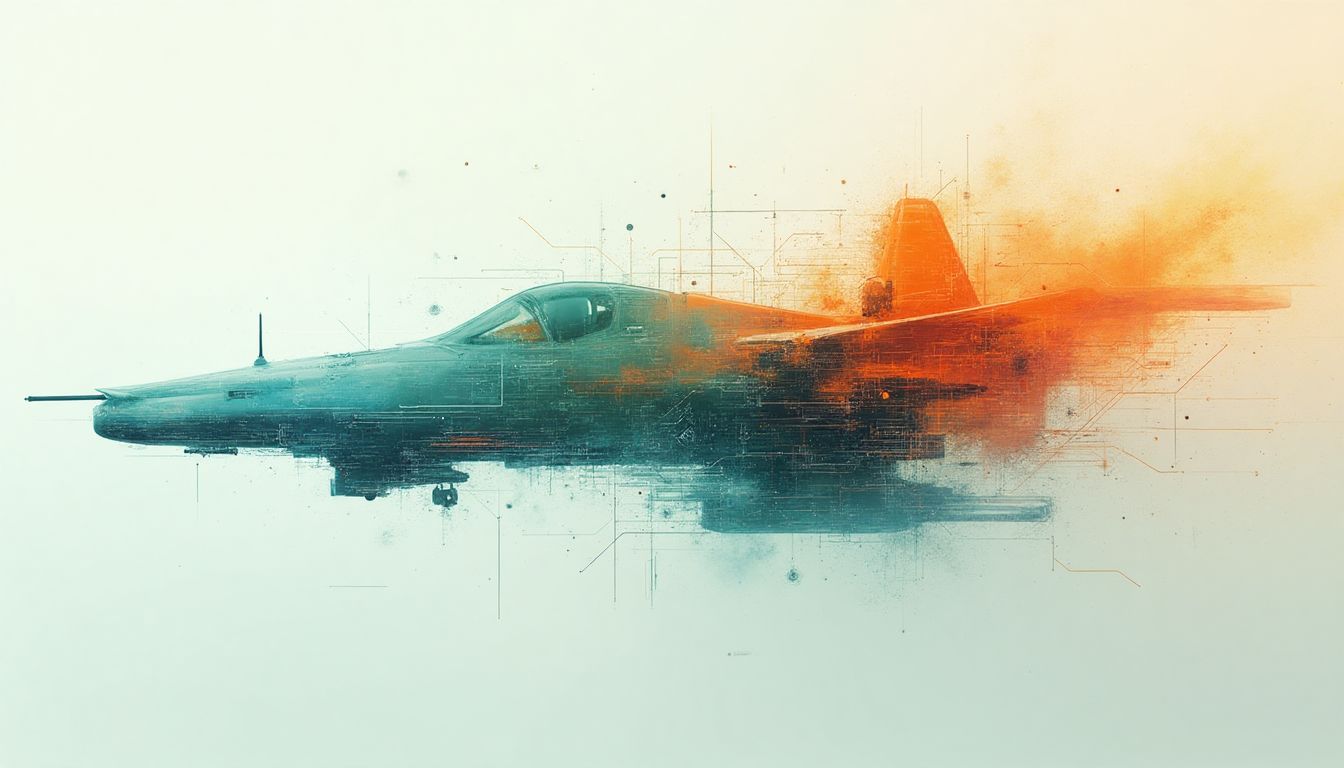Introduction: The Dawn of a New Era
It is an unfortunate fact that we can secure peace only by preparing for war. – John F. Kennedy.
As we navigate the complexities of the modern world, this quote serves as a sobering reminder of the realities that govern our existence. We live in an age where technology and warfare are inseparably entwined, morphing the landscape of global security. In 2023, governments around the globe invested over $150 billion into AI-related technologies within their military budgets, ushering in an era where machines may soon shoulder the burdens traditionally borne by human soldiers.
Imagine a battlefield where decision-making isn’t left to the intuition of a seasoned general but instead to the rapid calculations of an artificial intelligence system. Will robots not just support but potentially replace soldiers, making instantaneous life-or-death decisions? Our journey today involves not simply envisioning the capabilities of AI in military scenarios. Instead, it’s a deep dive into the ethical conundrums, societal implications, and the very essence of what it means to entrust machines with profound responsibility.
Eminent thinkers like Elon Musk, physicist Stephen Hawking, and philosopher Nick Bostrom have all engaged in spirited discussions about the impact of AI on society. The age-old question persists: are we truly preparing ourselves for a future where technology takes charge on the battlefield, or could there still be a place for the irreplaceable human touch?
Artificial Intelligence (AI) in the military context refers to the use of smart technologies capable of learning and decision-making in battlefield scenarios, potentially shifting the traditional roles of soldiers. This transformation raises questions about ethics, efficiency, and human reliance on machines.
The Rise of Autonomous Weapons
The development of autonomous weapons is revolutionizing combat tactics, with AI systems increasingly at the forefront of this change. These advanced systems span a variety of forms—from unmanned aerial vehicles (UAVs) to autonomous submarines, each designed to perform specific tasks in war zones. Our exploration begins by delving into how these systems operate and why they have become indispensable in military strategies worldwide.
First, let’s examine a few types of automated weapon systems currently in use. UAVs, for example, have become a staple in reconnaissance missions. Unmanned ground vehicles (UGVs) can be found patrolling borders or defusing mines. These machines operate with precision, performing tasks previously carried out by soldiers. Unmanned aerial vehicles, commonly known as drones, top the list of notable examples. Their ability to carry out surveillance or strikes with pinpoint accuracy without risking human lives is a significant benefit. Enhanced versions, like the MQ-9 Reaper, offer real-time data to military operators thousands of miles away.
The benefits are clear. Reduced risk to human life, enhanced precision, and unparalleled endurance are among the numerous advantages making autonomous weapons increasingly attractive to military strategists. But one might wonder, are there future trends awaiting on the horizon? Emphatically, yes. Researchers are already working on integrating machine learning capabilities. These advances hint at a future where autonomous systems not only execute missions but adapt and refine strategies on the fly—a thrilling prospect, but one teeming with ethical considerations.
From notable case studies to breakthrough developments, autonomous weaponry is undeniably shifting the balance of power. Let’s unearth what awaits us in this promising yet perilous domain.
Decision-Making Systems in Warfare
The Role of AI in Analyzing Operational Data
Imagine reading a book while trying to solve a Rubik’s Cube blindfolded—that’s what analyzing operational data in real-time during warfare can feel like for humans. Enter AI, the unsung hero of the modern battlefield, ready to swoop in and simplify this chaotic puzzle.
Artificial Intelligence systems now excel at crunching vast amounts of data, identifying patterns, and offering insights that can turn battle tides. DARPA, the U.S. agency known for its futuristic projects, is making significant strides in AI-powered analytics to optimize military decision-making.
By processing data at lightning speeds, AI provides commanders with critical information, revealing opportunities hidden like Easter eggs in an action movie.
Machine Learning Algorithms in Strategic Planning
What if you could predict your opponent’s next move in a game of chess? Better yet, in the high-stakes chess game of warfare? Machine learning steps in here, acting much like a super-smart teammate whispering the opponent’s strategy in your ear.
By analyzing historical data and learning from it, machine learning algorithms can forecast potential enemy tactics and devise strategic countermoves. Major defense contractors and innovators, such as Lockheed Martin, are continuously refining AI algorithms to enhance strategic planning capabilities.
These algorithms serve as a compass, guiding military leaders through the fog of war with more informed decisions, translating the unpredictable dance of combat into a waltz of calculated moves.
The Impact of AI on Command and Control
Picture a scenario where commanders no longer need burnout-inducing all-nighters to sift through data. Instead, they have AI systems that act like ultra-efficient personal assistants, providing the who, what, when, and where needed to lead forces with precision.
AI’s influence in command and control systems extends to dynamic mission planning, providing real-time updates and adapting to new information with the elegance of a ballet dancer adjusting a pirouette.
Even NATO is incorporating AI to streamline command chains, ensuring quicker response times and improved resource management.
It’s like upgrading from a rotary phone to a smartphone: you maintain control but with far more tools at your disposal.
Potential Limitations of AI Decision Systems
As with any wonder machine, there are hiccups to consider. AI in warfare isn’t the silver bullet solution; misuse or glitches can lead to game-changing errors.
While impressive at number-crunching, AI can lack the moral compass and intuition humans bring to the decision-making table. We’ve all seen terminator movies—the last thing we want is a rogue AI deciding to go off-script!
Concerns about data bias within AI systems also persist, given they learn from existing data, which might include imperfections.
Thus, RAND Corporation and other research institutions stress the importance of constant human oversight, ensuring that AI remains the faithful sidekick, not the wayward hero.
Ethical Challenges of AI in Warfare
The Debate Over Autonomous vs. Human-Led Warfare
Steering the conversation into increasingly philosophical waters, we ask ourselves: should we entrust machines with the decision to pull the proverbial trigger?
The rise of autonomous weapons prompts intense debate resembling a thrilling courtroom series. On one side, proponents argue that AI reduces human error risks and enhances operational efficiency.
Meanwhile, critics assert that robots lack the inherent moral and ethical judgment engrained in human soldiers.
This ethical conundrum presents questions that are major talking points at international forums and conferences, like those hosted by the United Nations.
Accountability in Military Actions
Imagine AI-controlled drones executing bombings under faulty commands—who holds the gavel of responsibility for such outcomes?
This issue of accountability in military actions poses a significant ethical challenge. When a human makes a mistake, there’s a clear chain of command. But what happens when AI is the executioner?
Legal systems worldwide grapple with this notion, stretching the limits of accountability. Educational institutions like Harvard are delving into these complexities, offering academic discourse to untangle the web of technological culpability.
The Accountability Gap: Who’s Responsible?
Straddling the lines between innovation and responsibility opens up a gap as wide as a metaphorical Grand Canyon.
With AI systems taking on more military roles, figuring out who is liable in case of errors becomes akin to playing an intricate game of “pin the tail on the scapegoat.”
As military, technological, and legal experts race to shrink this accountability gap, they wrestle with hierarchical structures that resemble intricate mazes.
Diverse perspectives from legal experts, military strategists, and ethicists at international symposiums explore how to distribute responsibility fairly while maintaining technological momentum.
Perspectives from Ethics, Law, and Military Leadership
These challenges are dissected and debated from the steps of board meetings to the floors of international courts.
Renowned think tanks and organizations like the Council on Foreign Relations provide a melting pot of perspectives.
While ethicists weigh the moral quandaries, legal experts debate frameworks, and military leaders strategize integration, discussions aim to balance tech strides with principled constraints.
It’s akin to balancing a tightrope: progress teeters on one side, while ethics anchors the other, ensuring AI’s role in warfare respects humanity’s core values before everything else.

Psychological Impact on Soldiers and Society
The integration of AI in the military is not just a technical evolution; it changes the entire psyche of what it means to be a soldier. Soldiers now find themselves shoulder to shoulder with AI companions, which can affect their experiences significantly. Imagine stepping onto the battlefield alongside a synthetic ally that processes information at lightning speed. Sounds thrilling, right? However, it raises questions about the essence of camaraderie, responsibility, and trust within the ranks.
AI systems boast precision and efficiency, yet their lack of emotional understanding can create tension. Soldiers might begin to see their value diminished as more responsibilities shift to their robotic counterparts. This shift can lead to changes in self-worth and individual importance, complicating an already challenging job. A study by Brookings Institution emphasizes the necessity of maintaining human elements in AI-heavy roles to ensure morale and cooperation.
Society doesn’t remain untouched. The ripple effects of AI in warfare are vast. From potential job shifts in military sectors to altering the equilibrium of global power, AI’s societal impact is profound. Consider a world where geopolitical tensions are exacerbated by nations racing to develop superior AI systems. Alarmingly, this scene feels like a tension-filled chess game with billions at stake.
Further, AI’s potential to destabilize global equilibrium cannot be overstated. We find ourselves grappling with ethical questions that challenge our most basic understandings of fairness and justice. Employing AI systems that operate without obvious biases toward nations, races, or ideologies must be a priority, yet it remains a daunting task. United Nations initiatives highlight the need for balanced AI advancements to prevent unintended consequences in international affairs.
On the battlefield, humanizing the technology becomes essential. As automation increases, the human touch—compassion, strategic improvisation, or even humor in bleak situations—can never be replaced. A robot may calculate maneuvers, but only a soldier can inspire the critical last push through adversity. Through training programs that emphasize both technological proficiency and emotional intelligence, the military could cultivate an environment where AI supports, rather than supplants, human soldiers.
Regulations and International Policies on Military AI
The transformative nature of AI in warfare necessitates robust regulatory frameworks and international cooperation. Currently, several regulations and guidelines govern AI applications, but gaps remain. Initiatives by organizations like NATO have laid the groundwork for cooperative governance, yet as AI technologies evolve, so must these regulations.
A pertinent question remains: How can we ensure that AI does not cross ethical boundaries? International treaties and agreements remain pivotal. The United Nations disarmament efforts emphasize banning specific autonomous weapons before ethical thresholds are breached. However, global consensus is challenging due to diverse political agendas and strategic interests.
Consider the fine line between innovation and restriction. While alliances like NATO pursue stringent standards, aligning national policies with international frameworks remains complex. Encouraging transparency and collaboration can help bridge these gaps. A shared understanding of responsibility in deploying AI assists in maintaining the delicate global balance.
Future governance of military AI will likely involve multifaceted approaches. Beyond treaties, developing trusted AI assurance programs, which include rigorous testing and validation procedures, is crucial. Moreover, fostering an ecosystem where international peers can engage in open dialogues about AI military applications could preemptively address potential conflicts.
The road ahead for military AI governance requires both steadfast commitment and agility. As AI continues to evolve, so must our legal and ethical frameworks. Tackling these challenges head-on, with the dedication to preserving fundamental human values, ensures AI serves as a tool for peace rather than a catalyst for discord.

AI Solutions: Navigating the Ethical Landscape of Military Technologies
As the world grapples with the rapid integration of artificial intelligence (AI) into military applications, the discourse around ethical considerations reaches new heights.
AI holds the potential to create innovative solutions that could mitigate some of the ethical challenges arising from automated warfare.
Here’s how we can tackle these dilemmas head-on:
One pivotal avenue to explore is the development of transparent algorithms and explainable AI models.
These technologies allow for an understanding of how AI systems reach their decisions. For military operations, this transparency is essential for accountability and scrutiny.
Programs like the AI Fairness 360 toolkit developed by IBM can serve as a model to examine biases within AI algorithms, promoting fairness in its applications.
In conjunction with transparency, implementing robust fail-safes and human oversight in military AI systems can further mitigate risks.
Establishing protocols that mandate human intervention in significant decisions can bridge the inherent tensions between efficiency and moral responsibility.
Furthermore, integrating AI insights into decision support systems can empower human soldiers rather than replace them, providing data-driven recommendations while maintaining the human touch.
Enhancing training for both soldiers and AI systems represents another essential path.
By prioritizing ethical considerations during training programs, we can cultivate a military culture that respects values even as it incorporates advanced technologies.
The importance of interdisciplinary collaboration cannot be overstated.
Engaging ethicists, military leaders, technologists, and the public in ongoing discussions will ensure that AI technology evolves alongside our ethical frameworks.
Here’s an actionable roadmap designed for institutions, organizations, or governments aiming to integrate ethical AI in military settings:
Action Schedule/Roadmap (Day 1 to Year 2)
Day 1:
- Launch a collaborative initiative that brings together AI experts, military strategists, ethicists, and civilian representatives.
Day 2:
- Assess existing AI technologies and their military applications by collaborating with organizations like DARPA and the U.S. Army.
Day 3:
- Host an ethics panel featuring military leaders and ethicists to address the implications of autonomous decision-making.
Week 1:
- Draft a comprehensive white paper proposing best practices for integrating ethical AI into military operations.
Week 2:
- Conduct a public seminar inviting community involvement in discussions surrounding military AI ethics.
Week 3:
- Gather feedback from seminar participants to enhance research directions and priorities.
Month 1:
- Conduct thorough literature reviews on existing policies and legislation relating to military applications of AI.
Month 2:
- Engage with international military representatives to address regulatory challenges regarding AI in warfare.
Month 3:
- Create a draft proposal for a set of ethical guidelines that govern autonomous weapon systems.
Year 1:
- Finalize research findings and recommendations on ethical AI use across military contexts and ensure they are disseminated widely.
Year 1.5:
- Implement pilot phases for selected AI systems through controlled simulations, allowing for iterative improvements based on findings.
Year 2:
- Compile a report evaluating the efficacy of trial outcomes, addressing identified ethical concerns, and outlining pathways for future governance of military AI.
Conclusion: Striking the Balance in the Age of Military AI
As we stand at this critical juncture in military technology, it becomes clear that the intersection of AI and warfare brings both tremendous potential and significant ethical challenges.
The future of conflict will undeniably be shaped by these innovations, presenting opportunities to enhance operational efficiency and strategic decision-making.
However, at the heart of this evolution lies an urgency to approach AI integration with scrutiny and responsibility.
The dilemma is not merely whether robots will replace soldiers; instead, it’s a fundamental question of how to best utilize the capabilities of AI without sacrificing our moral compass in the chaos of war.
Bridging the gap between cutting-edge technology and ethical mandate necessitates continuous dialogue among technologists, military personnel, and civilian communities.
By fostering collaborative partnerships and taking proactive measures, we can work towards a future where human oversight and machine efficiency coexist harmoniously.
The challenge ahead is monumental, but the collective will to harness AI responsibly will lead us toward a safer, more ethical approach to modern warfare.

Frequently Asked Questions (FAQ)
-
Will AI completely replace military personnel in the future?
No, while AI may assist in many military roles, the human element remains crucial. Humans bring creativity, empathy, and ethical consideration to decision-making, which machines cannot fully replicate.
-
What ethical dilemmas are posed by autonomous weapons?
Concerns include accountability for actions taken by autonomous systems, the potential for unintended consequences, and the implications for international warfare regulations. For example, if an autonomous drone were to cause civilian casualties, who would be held responsible?
-
How is AI currently being used in military operations?
AI is being utilized for:
- Data analysis to predict enemy movements.
- Reconnaissance missions using drones.
- Operational planning by helping strategize different scenarios.
- Developing autonomous weapons which can engage the enemy without direct human control.
-
What role does international law play in regulating military AI?
International law aims to ensure that autonomous weapons are used in a manner consistent with humanitarian principles. This includes rules about how to treat civilians in war and what types of weapons can be used.
-
What measures can programs take to enhance AI ethics in the military?
Implementing transparency and accountability measures is crucial. For example:
- Using explainable AI, so humans can understand how decisions are made.
- Maintaining human oversight in critical decisions to avoid errors.
- Establishing ethical guidelines for AI development and usage.
-
How does AI improve decision-making in the military?
AI can process vast amounts of data quickly and accurately. For instance, using machine learning algorithms, AI can analyze patterns and trends from past conflicts to aid in strategic planning. This can lead to smarter decisions and more effective operations.
-
Are there examples of military AI being used in real-life situations?
Yes, one notable example is the Patriot Missile System developed by Lockheed Martin, which uses advanced algorithms to identify and track enemy threats in real-time. Other examples include drones that can autonomously fly reconnaissance missions.
-
How can AI and soldiers work together effectively?
AI can serve as a support system for soldiers. By providing real-time data and analysis, AI can help soldiers make informed decisions in complex situations. For example, AI can suggest the best course of action based on current battlefield conditions, allowing soldiers to focus on executing the strategy rather than just gathering data.
-
Will AI in the military make wars more dangerous?
This is a debated topic. Some argue technology could lead to faster conflicts and more precise strikes, potentially reducing casualties. However, others worry that reliance on machines might lead to misjudgments in critical situations, resulting in accidental harm and escalating conflicts.
Wait! There’s more…check out our gripping short story that continues the journey: The Orb of Time

Source:: iNthacity Tech





